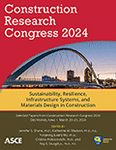Reuse and Recycling Feasibility Assessment for Bridge Components: A Case Study of a Bridge Investigation in Florida
Publication: Construction Research Congress 2024
ABSTRACT
Demolition waste is a significant issue in the world. Over the years, different methods for extending the lifespan of construction materials and reducing demolition waste through reuse and recycling have been investigated. Specifically, concrete bridges have significant potential for material recovery due to not only the substantial amount of materials used but also the possibility of their retaining nearly the same or similar properties across bridge life cycles. Most bridges are demolished not due to their structural deficiency but because they are functionally obsolete. In the literature on circularity and waste management, however, bridges are rarely considered. This paper quantitatively assesses the reusability and recyclability of different components of a bridge in Florida. Moreover, the reuse and recycling costs for bridge components and their resulting material savings are calculated and compared with their non-sustainable demolition options to decide the most sustainable but still economically feasible options based on their benefit-cost ratios. This study specifically examines how parameters like component uniqueness, time, and transportation affect the feasibility of bridge components for reuse or recycling and suggests the most sustainable demolition plan.
Get full access to this article
View all available purchase options and get full access to this chapter.
REFERENCES
Aïtcin, P.-C., and S. Mindess. 2011. Sustainability of concrete. CRC Press.
AISC. 2023. “Why Steel.” Accessed May 1, 2023. https://www.aisc.org/why-steel/sustainability/recycling/.
Anastasiades, K., J. Blom, M. Buyle, and A. Audenaert. 2020. “Translating the circular economy to bridge construction: Lessons learnt from a critical literature review.” Renewable and Sustainable Energy Reviews, 117: 109522. https://doi.org/https://doi.org/10.1016/j.rser.2019.109522.
Arora, M., F. Raspall, L. Cheah, and A. Silva. 2019. “Residential building material stocks and component-level circularity: The case of Singapore.” J Clean Prod, 216: 239–248. https://doi.org/https://doi.org/10.1016/j.jclepro.2019.01.199.
ASCE’s 2021 Infrastructure Report Card. 2021. Bridges.
Azizinamini, A. 2014. “The many faces of bridge engineering.” Accessed May 8, 2023. https://intrans.iastate.edu/news/the-many-faces-of-bridge-engineering/.
Cho, N., M. El Asmar, and M. Aldaaja. 2022. “An Analysis of the Impact of the Circular Economy Application on Construction and Demolition Waste in the United States of America.” Sustainability, 14 (16): 10034. MDPI.
Coenen, T. B. J., J. Santos, S. A. A. M. Fennis, and J. I. M. Halman. 2021. “Development of a bridge circularity assessment framework to promote resource efficiency in infrastructure projects.” J Ind Ecol, 25 (2): 288–304. John Wiley & Sons, Ltd. https://doi.org/https://doi.org/10.1111/jiec.13102.
Cooper, F. L. 2008. Recovery, Reuse, and Recycling of Debris From the Demolition of the Grace and Pearman Bridges At Charleston, South Carolina.
“Disposal Fee in Gulf county Florida.” 2023. Accessed April 23, 2023. https://www.gulfcounty-fl.gov/county_government/public_works/solid_waste.
Domínguez, A., M. I. Domínguez, S. Ivanova, M. A. Centeno, and J. A. Odriozola. 2016. “Recycling of construction and demolition waste generated by building infrastructure for the production of glassy materials.” Ceram Int, 42 (14): 15217–15223. Elsevier.
EPA. 2012. Recycling Fee Rate Calculation and Sample Exercises.
Fernanda, C. R., G. David, and B. Melissa. 2021. “Barriers and Enablers to Circular Building Design in the US: An Empirical Study.” J Constr Eng Manag, 147 (10): 04021117. American Society of Civil Engineers. https://doi.org/10.1061/(ASCE)CO.1943-7862.0002109.
“Florida Scrap Metal Prices - USA.” 2023. Accessed May 2, 2023. https://www.priceofscrapmetals.com/florida/.
Jin, R., and Q. Chen. 2015. “Investigation of Concrete Recycling in the U.S. Construction Industry.” Procedia Eng, 118: 894–901. https://doi.org/https://doi.org/10.1016/j.proeng.2015.08.528.
Luangcharoenrat, C., S. Intrachooto, V. Peansupap, and W. Sutthinarakorn. 2019. “Factors influencing construction waste generation in building construction: Thailand’s perspective.” Sustainability, 11 (13): 3638. MDPI.
Michael Tobias. 2019. “Transporting concrete.” Accessed April 23, 2023. https://www.ny-engineers.com/blog/recycling-and-reusing-concrete.
Moynihan, M., and J. Allwood. 2012. “The flow of steel into the construction sector.” Resour Conserv Recycl, 68: 88–95. https://doi.org/10.1016/j.resconrec.2012.08.009.
O’Grady, T., R. Minunno, H.-Y. Chong, and G. M. Morrison. 2021. “Design for disassembly, deconstruction and resilience: A circular economy index for the built environment.” Resour Conserv Recycl, 175: 105847. Elsevier.
Purchase, C. K., D. M. Al Zulayq, B. T. O’Brien, M. J. Kowalewski, A. Berenjian, A. H. Tarighaleslami, and M. Seifan. 2022. “Circular economy of construction and demolition waste: A literature review on lessons, challenges, and benefits.” Materials, 15 (1): 76. Multidisciplinary Digital Publishing Institute.
Van Vliet, M., J. Van Grinsven, and J. Teunizen. 2021. Circular buildings—Meetmethodiek Losmaakbaarheid. V 2.0. Alba Concepts.
Wang, Y., Y. Tang, and W. Yao. 2017. “Research on the whole process management of construction waste.” ICCREM 2016: BIM application and off-site construction, 398–405. American Society of Civil Engineers Reston, VA.
Wardhana, K., and F. C. Hadipriono. 2003. “Analysis of recent bridge failures in the United States.” Journal of performance of constructed facilities, 17 (3): 144–150. American Society of Civil Engineers.
Will, H., J. Hiba, M. Mohammad, and C. Juyeong. 2023. “Sustainable Management of the Built Environment from the Life Cycle Perspective.” Journal of Management in Engineering, 39 (2): 03123001. American Society of Civil Engineers. https://doi.org/10.1061/JMENEA.MEENG-4759.
Information & Authors
Information
Published In
History
Published online: Mar 18, 2024
Authors
Metrics & Citations
Metrics
Citations
Download citation
If you have the appropriate software installed, you can download article citation data to the citation manager of your choice. Simply select your manager software from the list below and click Download.
